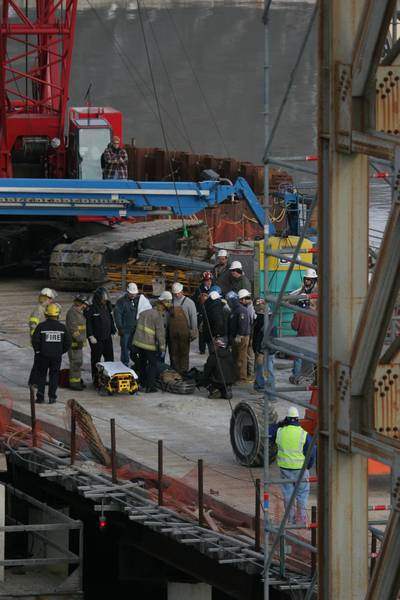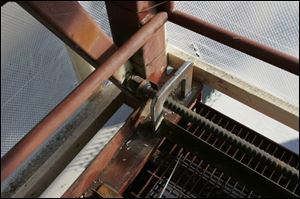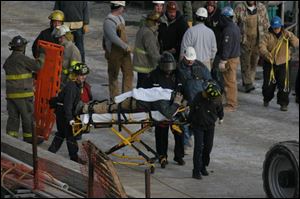
2 worker injuries at site of 04 deaths rattle nerves
1/27/2006
Rescuers remove an injured ironworker from the I-280 bridge construction area.

Rescuers remove an injured ironworker from the I-280 bridge construction area.
Two calls. Fifteen minutes and nearly a mile apart.
The 911 requests for ambulances on the I-280 Veterans Glass City Skyway construction project yesterday morning undoubtedly caused more anxiety than usual for police, emergency responders, and workers on the job at Ohio s most expensive construction project ever.
Memories are still raw with the images of a truss crane collapse that killed four ironworkers on Feb. 16, 2004, during work on an elevated approach to the new I-280 bridge in East Toledo.
Fortunately, the circumstances yesterday ultimately turned out to be, by comparison, far less serious.
Josh Brandt, 28, of Toledo, was treated at St. Charles Mercy Hospital and released later in the day, while Dan Lindenberger, 27, of Toledo, was admitted to St. Vincent Mercy Medical Center for overnight observation, authorities said. In the first incident, reported at 9:30 a.m., Mr. Brandt was working near a winch that was pulling cables through conduits in a bridge span between Michigan and Ontario streets. A weld on a bar anchoring the winch suddenly failed, causing the winch to shift and strike him in the legs, other workers nearby told investigators.

The weld s failure at the end of this bar is thought to have caused the winch to shift and strike Josh Brandt, who was treated at St. Charles Mercy Hospital and released. The other worker, Dan Lindenberger, was taken to St. Vincent Mercy Medical Center for observation.
In the second accident, reported at 9:45, Mr. Lindenberger was standing on a catwalk atop a construction truss and helping feed a safety cable underneath the equipment when excess slack in the cable looped around his legs and snagged them, said Rich Martinko, the Ohio Department of Transportation s assistant director for highway operations.
Whether Mr. Lindenberger was injured by the cable itself or by an ensuing fall atop the catwalk remained to be determined, Mr. Martinko said.
Both men are members of Ironworkers Local 55, the same union representing the four men who died in the 2004 crane collapse.
Joe Blaze, the local s business manager, acknowledged that project workers are still healing from the 2004 disaster, but emphasized that the accidents yesterday were of a nature typically found with heavy construction operations and were not cause for any further concern about the I-280 project s safety.
Iron work is dangerous work, and these kinds of incidents bring that to light, Mr. Blaze said. Thank God, in this incident, no one was seriously injured.

An emergency crew removes an injured worker from the I-280 bridge construction area.
Mr. Martinko agreed. Construction of a project of this magnitude is not without risk, he said. One of our goals is to minimize that risk.
Mr. Blaze said he spent most of the day fielding telephone calls from workers worried relatives after initial reports circulated that the injuries involved were more serious. Fueling those reports, he said, were the extra care rescue crews took merely as precautionary measures against the possibility of more serious injury in removing both men from the accident scenes.
Everybody at the job site has cell phones, so rumors spread, he said.
The $220 million bridge over the Maumee River is being assembled from precast concrete segments,
While held in place by trusses, the segments in each span of the bridge are glued to each other with epoxy and then compressed together by cables that are strung through them and then placed under tension by high-pressure jacks.
The first accident yesterday occurred while workers were threading one such cable through the epoxied segments of a span. The tensioning cable is drawn through conduit by a smaller cable attached to a winch that is clamped to a heavy anchoring bar that is, in turn, welded to a platform attached to the end of the span being finished.
The second accident occurred as a backup safety cable was being draped beneath one of the bridge-building trusses before it was moved. The underslung truss has finished building the southbound lanes on the East Toledo side of the main river span and is to be moved to another part of the bridge project site.
Jule Hovi, area director for the federal Occupational Safety and Health Administration, said by phone her office had sent investigators to the scenes of both accidents yesterday.
OSHA, ODOT, the ironworkers union, and contractor Fru-Con Construction all reviewed the two accidents yesterday and approved the resumption of work at the first accident site by early afternoon, Mr. Martinko said. Operations near the second accident scene are likely to resume this morning with minimal delay to the overall project, he said.
Construction of the cable-stayed bridge over the Maumee River was delayed by nearly 16 months after the 2004 crane collapse, which also injured four other men, and a second crane-related incident Oct. 23, 2004, in which a falling crane leg narrowly missed workers.
OSHA assessed Fru-Con, based in Ballwin, Mo., a $280,000 fine for the fatal accident, a fine to which the contractor consented in a settlement with the regulatory agency last August. The contractor is contesting a $70,000 fine that OSHA assessed for the second incident, which occurred after a miswired controlled caused a mechanical cable to fail and send a crane leg plummeting from its housing.
The Lucas County prosecutor s office has an ongoing investigation into the fatal accident, which OSHA blamed on a failure to properly anchor one end of the crane that collapsed before repositioning the other end.
John Weglian, chief of the prosecutor s special units division, said his office is negotiating with an engineering consultant it wishes to hire to review evidence to determine if there was any criminal wrongdoing.
Time is not an issue, Mr. Weglian said, because the statute of limitations for involuntary manslaughter a likely charge if criminal recklessness is alleged is 20 years.
Contact David Patch at: dpatch@theblade.com or 419-724-6094.